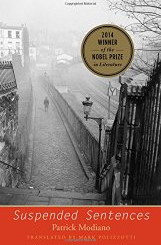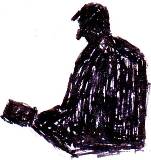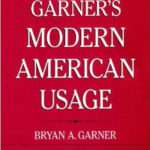 Suspended Sentences
Suspended Sentences
Fiction (Translation)
Yale University Press

Patrick Modiano pursues his characters with the meticulousness of a private detective. It seems that he is obsessed with the "riddle of human identity".
“At times it seems our memories act much like Polaroids,” says the narrator in Patrick Modiano’s short novel Afterimage. Indeed in these novellas the writer’s memory resembles a Polaroid Camera. There is a first person narrative voice in all the three pieces and although we have three different pieces of fiction here, the book almost reads like a continuous narrative, a chronicle, a memoir or a diary. As the narrator delineates the events and describes the characters and their actions, a kaleidoscope of black and white or sepia images move in front of our vision. We are instantly transported to an obscure and mysterious world of the past and the entrance and exits of people only add on to an intriguing confusion. Yet, such is the magic of these imperfect recollections and incomplete histories that they tend to keep the readers under their spell and it is difficult to put the book down.
The first of these (Afterimage) narrates the search for a taciturn photographer Francis Jansen whom the narrator knew and worked for but whose sudden disappearance decades ago prompted the narrator to try and find his trail not merely because he knew the man personally but also because he wanted to know the mystery behind the photographer, he wanted to know why Jansen turned so resolutely away from life in his later years. With a few deft touches Modiano can portray a character: “He was a man of few words, he did everything he could to be forgotten………………..I only have to look at his photos to rediscover the quality he possessed in art as in life, which is so precious but so hard to acquire: keeping silent.”
In the second (Suspended Sentences) the narrator is a ten-year-old boy who describes the hazy and somewhat seedy world of the adults. The boy and his brother are abandoned by their parents and dumped down in the house of some acquaintances. The boys live among adults, all women, whom they hardly know. The women have visitors and some of them venture outside the house and the boys remain observers of events in an adult world which they hardly understand. There is a pervading sense of confusion and sadness in the world of these boys and their abandonment adds on to that confusion. When someone asked the boy about the whereabouts of his parents, he tried to find an answer but couldn’t: “It was too complicated to explain.”
This short fiction that has many autobiographical elements and it bears witness to how brilliantly Modiano uses the voice of a child-narrator and explores the world through his eyes. Like the adult novelist, the boy too seems to have strange attachments with buildings, garages and places. Perhaps he tries to take refuge in their apparent permanence in order to escape from the adult world of flux. But there too he has disappointments: “They tore it down with the others and all those years have become for me, nothing but a long and vain search for a lost garage.”
The third piece (Flowers in the Rain) begins with the description of an incident of unnatural death of a young couple and the narrator tries to trace the events decades after the incident actually happened. He appears to have lost trail and found the nebulous identity of Pacheco worthy of his pursuit. Pacheco is a mysterious man who claims to be a steward but intriguingly usurps the identity of another man who was missing and had a distinguished ancestry: “On the off chance, I searched for the names Bellune and Pacheco in the indexes of old newspapers that passed through my hands, like a ragman poking his hook into a pile of garbage.” That search, which shows Modiano’s fascination for what is lost and obscure takes him nowhere but the novel becomes an artist’s impression of a city and its quarters described in multiple and overlapping timeframes.
Patrick Modiano pursues his characters with the meticulousness of a private detective. It seems that he is obsessed with the “riddle of human identity”. With the help of phone books, directories, social registers, newspapers he tries to find the missing links in the lives of his characters many of whom have disappeared decades ago. Even when they appear in his novels, they have this tendency to suddenly disappear with an uncanny regularity. The writer tries to gather whatever concrete evidence he can about those fleeting souls and he often enlists his findings in the middle of his narration. In the narrator’s own words, “….I had taken on this job because I refused to accept that people and things could disappear without a trace. How could anyone resign himself to that?”
Besides the vagueness of his characters and the diligent scrupulousness of his attempts to trace their identities, the dominant thread that runs through these three short novels is the writer’s love for and intimate acquaintance with the city of Paris. Its quarters, its lanes and by-lanes, its buildings and structures are witnesses to a lost past. Modiano is provincial and to appreciate him well some familiarity with his locales will help: “Boulevard Saint-Michel is engulfed in a December-like fog this Sunday evening, and the image of a street resurfaces in my memory, one of the few streets in the Latin Quarter …….that often figures in my dreams.” He returns to certain quarters after several decades and describes their past. He is a chronicler of an old city. He finds old acquaintances who do not change, who remain “forever faithful to the sixties”. He observes and records for the posterity the “soft, limpid light” of Rue Cujas in the early sixties, a time in which that road “will always remain frozen” for him. Mapping the city is crucial for this writer as he attempts to solve the “enigma posed by a man he has no chance of finding again”.
Although this reviewer reads French he had to read Mark Polizzotti’s translation without any reference to the original versions as he couldn’t procure them at the time of writing this review. The English prose of this translation is simple, clear and direct and at times even lyrical. For the readers not yet familiar with this novelist, ‘Suspended Sentences’ will prove to be an interesting and intriguing read although it may not be a good starting point to begin a journey into the world of Patrick Modiano.
This is a review of an advance ‘proof copy’ of the book that the present reviewer was approved to read thanks to Netgalley.
Suspended Sentences: Three Novellas ; Patrick Modiano; Translated by Mark Polizzotti; Yale University Press; New Haven and London]
























